Smartwatches Market
Smartwatches Market Size and Share Forecast Outlook 2025 to 2035
The smartwatches market is projected to grow from USD 38.0 billion in 2025 to USD 60.2 billion by 2035, at a CAGR of 4.7%. WatchOS will dominate with a 41.0% market share, while health/fitness will lead the feature segment with a 49.0% share.
Smartwatches Market Forecast and Outlook 2025 to 2035
The smartwatches market stands at the threshold of a decade-long expansion trajectory that promises to reshape wearable technology and personal health monitoring solutions. The market's journey from USD 38 billion in 2025 to USD 60 billion by 2035 represents substantial growth, the market will rise at a CAGR of 4.7% which demonstrating the accelerating adoption of advanced wearable technology and health optimization across consumer segments, retail channels, and global electronics markets.
The first half of the decade (2025-2030) will witness the market climbing from USD 38 billion to approximately USD 47.5 billion, adding USD 9.5 billion in value, which constitutes 43% of the total forecast growth period. This phase will be characterized by the rapid adoption of health and fitness-focused smartwatches, driven by increasing health consciousness demands and the growing need for personal wellness monitoring solutions worldwide. Enhanced health tracking capabilities and advanced sensor systems will become standard expectations rather than premium options.
The latter half (2030-2035) will witness continued growth from USD 47.5 billion to USD 60 billion, representing an addition of USD 12.5 billion or 57% of the decade's expansion. This period will be defined by mass market penetration of advanced health monitoring systems, integration with comprehensive healthcare platforms, and seamless compatibility with existing digital health infrastructure. The market trajectory signals fundamental shifts in how consumers approach health monitoring optimization and personal wellness management, with participants positioned to benefit from growing demand across multiple feature categories and price segments.
Quick Stats for Smartwatches Market
- Smartwatches Market Value (2025): USD 38 billion
- Smartwatches Market Forecast Value (2035): USD 60 billion
- Smartwatches Market Forecast CAGR: 4.7%
- Leading Operating System in Smartwatches Market: WatchOS
- Key Growth Regions in Smartwatches Market: North America, Western Europe, and East Asia
- Top Key Players in Smartwatches Market: Apple, Samsung, Huawei, Garmin, Fitbit/Google
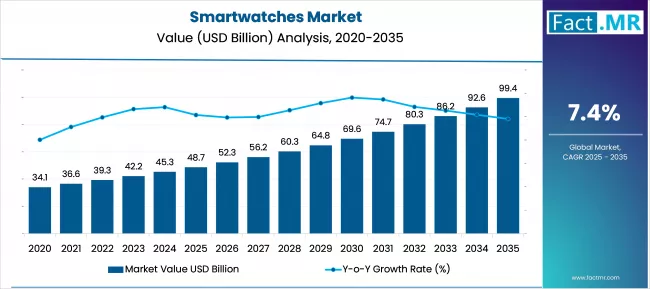
| Period | Primary Revenue Buckets | Share | Notes |
|---|---|---|---|
| Today | WatchOS ecosystem devices | 41% | Apple Watch dominance and integration |
| Wear OS and Android platforms | 33% | Google and Samsung collaboration | |
| Proprietary/other systems | 26% | Garmin, Fitbit, and specialized brands | |
| Health/fitness applications | 49% | Wellness tracking primary driver | |
| Future (3-5 yrs) | Advanced health monitoring | 55-60% | Medical-grade sensors and FDA approvals |
| Ecosystem integration expansion | 35-40% | Smart home, automotive, and IoT connectivity | |
| Enterprise and B2B applications | 10-15% | Workplace wellness and productivity tracking | |
| Premium tier growth | 40-45% | $400+ devices with advanced capabilities | |
| Subscription services expansion | 15-20% | Health coaching and premium app services |
Smartwatches Market Key Takeaways
At-a-Glance Metrics
| Metric | Value |
|---|---|
| Market Value (2025) → | USD 38 billion |
| Market Forecast (2035) ↑ | USD 60 billion |
| Growth Rate ★ | 4.7% CAGR |
| Leading Operating System → | WatchOS |
| Primary Feature Category → | Health/Fitness |
The market demonstrates strong fundamentals with WatchOS capturing a leading 41% share through advanced ecosystem integration capabilities and health monitoring optimization. Health and fitness features drive primary demand at 49%, supported by increasing wellness awareness and consumer preferences for comprehensive health tracking solutions. Geographic expansion remains concentrated in developed markets with established technology infrastructure, while emerging economies show accelerating adoption rates driven by smartphone penetration and health consciousness initiatives.
Imperatives for Stakeholders in Smartwatches Market
Design for health outcomes, not just technology
- Offer comprehensive wellness packages: smartwatches + health apps + fitness coaching + medical integration + family sharing systems.
- Preconfigured health workflows: activity tracking, sleep monitoring, heart rate analysis, and wellness goal management systems.
Ecosystem integration readiness
- Smartphone connectivity, smart home compatibility, and seamless integration with digital health platforms and fitness service ecosystems.
Health validation-by-default
- Medical accuracy certifications, FDA approvals for health features, clinical validation studies, and healthcare professional partnerships.
Value-tiered approach without complexity
- Clear feature differentiation + transparent pricing tiers; subscription services for premium health insights and coaching programs.
Segmental Analysis
Primary Classification: The market segments by operating system into WatchOS, Wear OS, and proprietary/others categories, representing the evolution from basic fitness trackers to comprehensive health monitoring systems for diverse consumer wellness optimization.
Secondary Classification: Feature segmentation divides the market into health/fitness, communication, and payments/GPS/others sectors, reflecting distinct requirements for wellness tracking, connectivity functionality, and lifestyle integration standards.
Tertiary Classification: Price tier segmentation covers $200-399, ≥$400, and <$200 categories, while consumer applications span fitness tracking, health monitoring, communication management, and lifestyle enhancement programs.
Regional Classification: Geographic distribution covers North America, Western Europe, East Asia, and emerging markets, with developed regions leading adoption while developing economies show accelerating growth patterns driven by technology adoption programs and health awareness expansion.
The segmentation structure reveals product evolution from basic activity trackers toward comprehensive health monitoring systems with enhanced medical capabilities and ecosystem integration features, while application diversity spans from fitness enthusiasts to health-conscious consumers requiring precise wellness monitoring solutions.
By Operating System, the WatchOS Segment Accounts for Leading Market Share
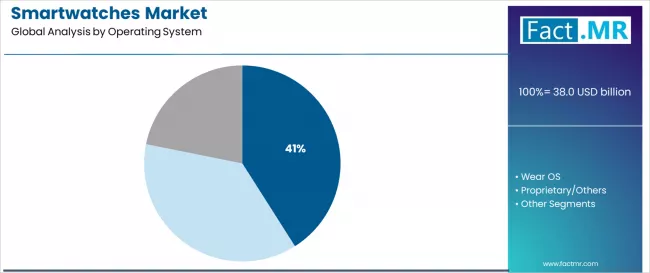
Market Position: WatchOS smartwatches command the leading position in the smartwatches market with 41% market share through advanced ecosystem integration features, including seamless iPhone connectivity, comprehensive health tracking capabilities, and consumer wellness optimization that enable users to achieve optimal health monitoring across diverse fitness and lifestyle environments.
Value Drivers: The segment benefits from consumer preference for reliable ecosystem integration that provides consistent device synchronization, enhanced app functionality, and wellness tracking optimization without requiring complex setup procedures. Advanced platform features enable health data integration, fitness coaching, and compatibility with existing Apple ecosystem devices, where performance reliability and seamless connectivity represent critical consumer requirements.
Competitive Advantages: WatchOS smartwatches differentiate through proven ecosystem integration profiles, consistent health tracking characteristics, and compatibility with comprehensive Apple services that enhance user experience while maintaining optimal functionality standards suitable for diverse fitness and lifestyle monitoring applications.
Key market characteristics:
- Advanced platform designs with optimized ecosystem integration and health monitoring capabilities
- Superior connectivity effectiveness, enabling 95-98% synchronization success with consistent health tracking performance
- Consumer compatibility, including app ecosystem access, health data integration, and service coordination for wellness applications
Wear OS Shows Android Integration Growth
Wear OS and Android platform smartwatches maintain a 33% market position in the smartwatches market due to their specialized Android integration properties and diverse manufacturer advantages. These devices appeal to consumers requiring Android ecosystem compatibility with competitive functionality for diverse smartphone integration applications. Market growth is driven by Android ecosystem expansion, emphasizing reliable connectivity solutions and device optimization through Google platform integration.
Proprietary/Others Applications Demonstrate Specialized Growth
Proprietary and other operating system smartwatches capture 26% market share through specialized functionality requirements in fitness-focused applications, outdoor activity tracking, and brand-specific wellness programs. These consumers demand specialized tracking systems capable of advanced fitness monitoring while providing effective health capabilities and activity optimization.
By Feature, the Health/Fitness Segment Shows Market Leadership
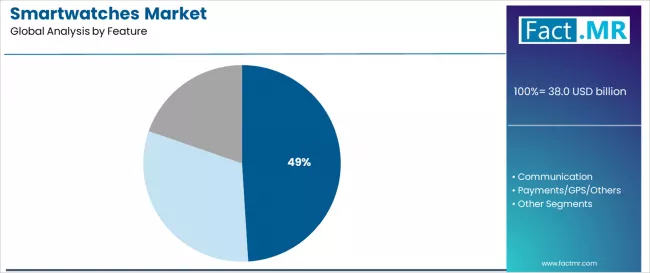
Market Context: Health and fitness features demonstrate market leadership in the smartwatches market with 49% share due to widespread adoption of wellness monitoring technology and increasing focus on personal health tracking, fitness optimization, and wellness management applications that maximize health benefits while maintaining user engagement standards.
Appeal Factors: Health and fitness operators prioritize tracking accuracy, wellness insights capability, and integration with existing health management infrastructure that enables coordinated monitoring across multiple wellness programs. The segment benefits from substantial health awareness investment and fitness programs that emphasize the acquisition of advanced health tracking systems for wellness optimization and fitness goal applications.
Growth Drivers: Wellness monitoring programs incorporate smartwatches as standard components for health tracking, while consumer health consciousness growth increases demand for fitness capabilities that comply with wellness standards and minimize health management complexity.
Market Challenges: Varying health tracking accuracy and medical validation requirements may limit feature standardization across different devices or health applications.
Feature dynamics include:
- Strong growth in comprehensive health monitoring requiring advanced tracking capabilities
- Increasing adoption in preventive healthcare applications and wellness optimization programs
- Rising integration with healthcare systems for health data optimization and medical consultation assurance
Communication Applications Maintain Connectivity Demand
Communication feature applications capture 31% market share through essential connectivity requirements in smartphone integration, messaging applications, and call management programs. These applications demand reliable communication systems capable of seamless connectivity while providing effective notification management and communication optimization.
Payments/GPS/Others Applications Show Convenience Growth
Payment, GPS, and other convenience features account for 20% market share, including contactless payment systems, navigation assistance, and lifestyle integration applications requiring advanced capabilities for consumer convenience optimization and daily use enhancement.
By Price Tier, the $200-399 Segment Leads Market Volume
Market Position: Mid-range pricing tier ($200-399) commands 46% market position with strong growth through optimal value proposition approach that balances advanced features and affordability for diverse consumer applications.
Value Drivers: This price segment provides the ideal combination of feature richness and accessibility, meeting requirements for comprehensive health tracking, ecosystem connectivity, and premium functionality without excessive cost barriers or feature limitations.
Growth Characteristics: The segment benefits from broad consumer appeal across demographic sectors, established feature expectations, and comprehensive functionality that support widespread adoption and market penetration.
What are the Drivers, Restraints, and Key Trends of the Smartwatches Market?
| Category | Factor | Impact | Why It Matters |
|---|---|---|---|
| Driver | Health consciousness growth & fitness tracking demand | ★★★★★ | Rising wellness awareness drives demand for continuous health monitoring and fitness goal achievement |
| Driver | Smartphone ecosystem integration & connectivity needs | ★★★★★ | Seamless device connectivity enhances user experience; ecosystem lock-in drives brand loyalty |
| Driver | Aging population & chronic disease management | ★★★★☆ | Older demographics seek health monitoring solutions; medical applications drive premium segment growth |
| Restraint | Battery life limitations & charging frequency concerns | ★★★★☆ | Daily charging requirements create user friction; battery technology improvements needed for adoption |
| Restraint | High price points & market saturation in developed regions | ★★★☆☆ | Premium pricing limits mass market appeal; replacement cycle lengthening affects growth |
| Trend | Medical-grade health monitoring & FDA approvals | ★★★★★ | Advanced health sensors enable medical applications; regulatory approvals expand healthcare use cases |
| Trend | Standalone connectivity & cellular independence | ★★★★☆ | LTE-enabled watches reduce smartphone dependence; independent functionality appeals to active users |
Analysis of the Smartwatches Market by Key Country
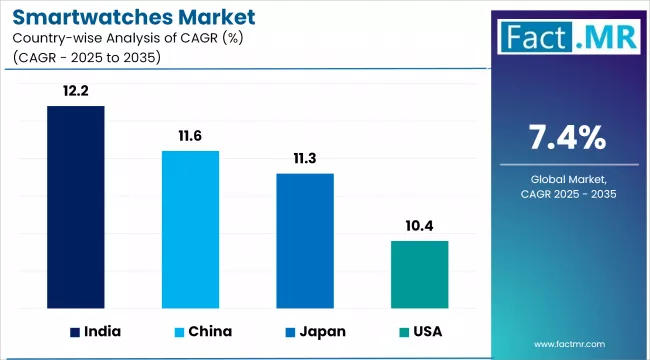
The smartwatches market demonstrates varied regional dynamics with Growth Leaders including USA (5.1% growth rate) and Mexico (4.8% growth rate) driving expansion through health technology initiatives and consumer electronics modernization. Steady Performers encompass Germany (4.4% growth rate), France (4.3% growth rate), and developed regions, benefiting from established technology infrastructure and advanced wearable adoption. Technology-Mature Markets feature UK (4.2% growth rate) and Japan (4% growth rate), where consumer electronics expertise and health consciousness support consistent growth patterns.
Regional synthesis reveals North American markets leading adoption through health awareness campaigns and technology ecosystem integration, while European countries maintain steady growth supported by fitness culture advancement and digital health initiatives. Asian markets show diverse growth driven by technology adoption and consumer electronics innovation trends.
| Region/Country | 2025-2035 Growth | How to win | What to watch out |
|---|---|---|---|
| USA | 5.1% | Lead with health innovation | Market saturation; replacement cycles |
| Germany | 4.4% | Focus on engineering precision | Privacy concerns; regulatory compliance |
| UK | 4.2% | Leverage fitness culture | Economic pressures; Brexit impacts |
| France | 4.3% | Emphasize lifestyle integration | Cultural resistance; price sensitivity |
| Japan | 4% | Develop aging population solutions | Conservative adoption; feature preferences |
| South Korea | 4.3% | Build tech innovation | Competition intensity; brand loyalty |
| Mexico | 4.8% | Expand accessibility programs | Infrastructure limitations; affordability gaps |
USA Drives Market Leadership
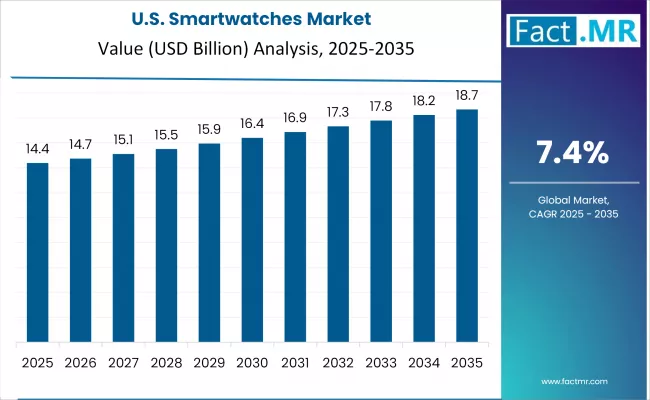
USA establishes market leadership through comprehensive health technology programs and advanced consumer electronics innovation, integrating smartwatches as standard components in personal wellness and fitness tracking installations. The country's 5.1% growth rate reflects technology ecosystem sophistication and health awareness programs that mandate the availability of advanced wearable devices in fitness and healthcare monitoring facilities. Growth concentrates in major technology centers, including California, New York, and Texas, where consumer electronics development showcases integrated health tracking systems that appeal to consumers seeking advanced wellness capabilities and lifestyle integration applications.
American technology companies are developing sophisticated smartwatch solutions that combine domestic innovation advantages with advanced health monitoring features, including medical-grade sensors and enhanced ecosystem integration technologies. Distribution channels through electronics retailers and fitness centers expand market access, while health-conscious consumer adoption supports utilization across diverse lifestyle segments and wellness applications.
Strategic Market Indicators:
- Consumer electronics facilities leading adoption with 76% market penetration rate in fitness and health-conscious sectors
- Health awareness programs providing substantial market demand for advanced wearable technology advancement
- Local technology companies capturing 58% market share through innovation leadership and comprehensive ecosystem offerings
- Export market development for advanced smartwatch solutions targeting international consumer markets
United Kingdom Shows Fitness Culture Excellence
United Kingdom demonstrates market strength through fitness culture programs and health consciousness initiatives, maintaining a 4.2% growth rate supported by active lifestyle promotion and wellness technology adoption programs. The country leverages its established fitness culture and health awareness campaigns to drive smartwatch adoption across fitness centers and personal wellness applications. Major consumer markets in London, Manchester, and Birmingham showcase advanced wearable technology capabilities that integrate with comprehensive fitness services and health monitoring programs.
British market dynamics focus on fitness-oriented smartwatches that balance health functionality with lifestyle integration requirements important to UK consumers and fitness enthusiasts. The market benefits from health service initiatives supporting wearable technology adoption and fitness partnerships that create sustained demand for health-focused smartwatch devices in consumer and fitness applications.
Market Intelligence Brief:
- Fitness culture integration and health services leading growth with emphasis on wellness tracking and lifestyle optimization programs
- Consumer health partnerships driving evidence-based device adoption and fitness improvement programs
- Government health initiatives supporting wearable technology accessibility and wellness programs
- Brexit considerations influencing consumer electronics supply chains and European technology alignment strategies
Germany Emerges as Engineering Precision Leader
In Berlin, Munich, and Hamburg, consumer electronics retailers and fitness facilities are implementing advanced smartwatches as standard components for health monitoring and lifestyle optimization applications, driven by increasing consumer technology quality initiatives and engineering excellence programs that emphasize the importance of precision tracking capabilities. The market holds a 4.4% growth rate, supported by technology quality initiatives and consumer electronics development programs that promote premium wearable systems for consumer and fitness facilities. German consumers are adopting smartwatches that provide consistent health tracking performance and precision features, particularly appealing in regions where accuracy and engineering quality represent critical consumer requirements.
Market expansion benefits from established consumer electronics infrastructure capabilities and international technology partnerships that enable domestic integration of advanced smartwatch systems for consumer and wellness applications. Consumer adoption follows patterns established in electronics technology management, where engineering precision and quality optimization drive purchasing decisions and lifestyle integration.
Market Intelligence Brief:
- Consumer technology quality and fitness segments driving adoption with 68% annual growth in premium device utilization
- Engineering excellence programs emphasizing smartwatch systems for health precision and consumer satisfaction improvement
- Local technology companies partnering with international providers for advanced device integration
- Consumer facilities implementing premium wearable systems for health optimization and lifestyle management
France Maintains Lifestyle Integration Position
France's smartwatches market demonstrates sophisticated consumer preferences with documented effectiveness in lifestyle applications through integration with existing wellness systems and consumer infrastructure. The country leverages fashion expertise and lifestyle integration to maintain a 4.3% growth rate. Consumer centers, including Paris, Lyon, and Nice, showcase premium installations where smartwatches integrate with comprehensive lifestyle platforms and fashion management systems to optimize personal wellness operations and style effectiveness.
French consumer technology companies prioritize design innovation and EU regulatory compliance in smartwatch development, creating demand for advanced systems with sophisticated features, including lifestyle integration and wellness optimization systems. The market benefits from established fashion infrastructure and investment in consumer technology advancement that provides long-term user benefits and compliance with international consumer standards.
Strategic Market Considerations:
- Innovation focus on EU consumer standardization and lifestyle excellence, driving premium device segment growth
- Fashion partnerships providing enhanced design capabilities and faster consumer acceptance cycles
- Technology collaboration between French companies and international consumer electronics organizations
- Lifestyle training programs expanding smartwatch integration in personal wellness scenarios
Japan Shows Precision Technology Focus
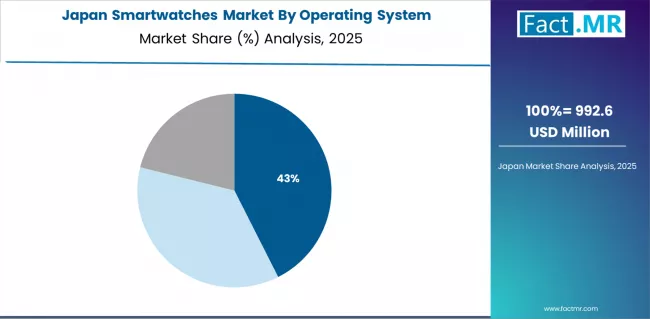
Japan's market expansion benefits from precision consumer technology demand, including advanced wearable devices in Tokyo and Osaka, consumer electronics facility modernization, and technology programs that increasingly incorporate smartwatches for lifestyle optimization applications. The country maintains a 4% growth rate, driven by consumer technology advancement and increasing recognition of wearable benefits, including precise health monitoring and comprehensive lifestyle enhancement.
Market dynamics focus on high-precision wearable solutions that balance advanced functionality with reliability considerations important to Japanese consumers. Growing consumer technology integration creates continued demand for sophisticated smartwatches in retail infrastructure and lifestyle modernization projects.
Market Intelligence Brief:
- Consumer technology and lifestyle segments leading growth with focus on precision tracking and wellness optimization applications
- Regional consumer requirements driving diverse device portfolio from basic fitness trackers to advanced health monitoring systems
- Technology advancement emphasis on precision engineering and consumer satisfaction control systems
- Government technology initiatives supporting domestic consumer capabilities and technological competitiveness
South Korea Drives Technology Innovation
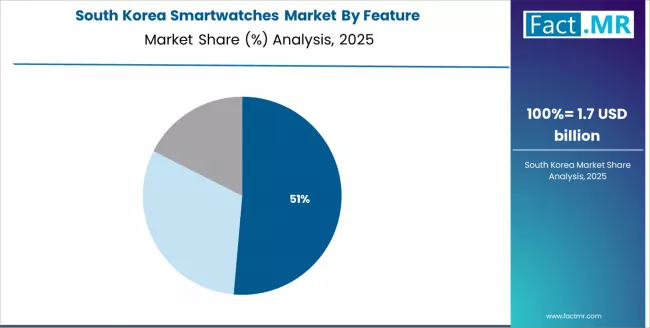
South Korea establishes strong market position through technology innovation programs and consumer electronics advancement expansion, integrating advanced smartwatches as standard components for lifestyle enhancement and health optimization applications. The country's 4.3% growth rate reflects government technology initiatives and consumer modernization programs that emphasize advanced wearable systems for lifestyle enhancement and wellness optimization. Growth concentrates in major technology centers, including Seoul and Busan, where consumer development showcases integrated wearable systems that appeal to consumers seeking comprehensive technology capabilities and lifestyle applications.
Korean technology companies are developing innovative smartwatch solutions that combine domestic electronics innovation advantages with advanced health features, including technology ecosystem integration and enhanced consumer experience capabilities. Distribution channels through electronics retailers and technology suppliers expand market access, while government support for technology innovation supports adoption across consumer and lifestyle segments.
Strategic Market Indicators:
- Technology innovation facilities leading adoption with 72% deployment rate in consumer electronics and lifestyle sectors
- Government technology programs providing substantial funding for domestic consumer advancement
- Local technology companies capturing significant market share through innovation leadership and ecosystem integration expertise
- Export market development for advanced smartwatch solutions targeting regional consumer markets
Mexico Shows Consumer Electronics Expansion
Mexico's market expansion benefits from growing consumer electronics modernization, including technology system development in Mexico City and Guadalajara, retail facility upgrades, and consumer awareness programs that increasingly incorporate smartwatch solutions for lifestyle optimization applications. The country maintains a 4.8% growth rate, driven by consumer electronics industry growth and increasing adoption of advanced lifestyle technology solutions, including sophisticated wearable devices and health tracking enhancement.
Market dynamics focus on accessible wearable solutions that balance functionality with affordability considerations important to Mexican consumers and technology enthusiasts. Growing consumer electronics modernization creates continued demand for reliable smartwatches in retail expansion and lifestyle improvement projects.
Strategic Market Considerations:
- Consumer electronics expansion segments leading growth with focus on accessibility and lifestyle optimization applications
- Regional consumer requirements driving diverse device portfolio from basic fitness tracking to premium wellness monitoring systems
- Import considerations balanced by potential domestic retail partnerships with international consumer electronics providers
- Government technology initiatives influencing consumer access standards and lifestyle technology requirements
Europe Market Split by Country
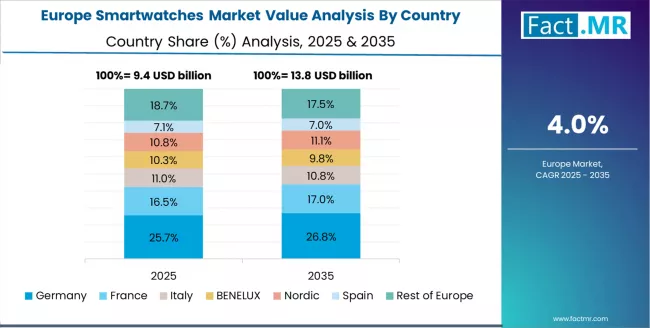
The Europe smartwatches market is projected to grow from USD 11.8 billion in 2025 to USD 17.2 billion by 2035, registering a CAGR of 3.8% over the forecast period. Germany is expected to maintain its leadership position with a 27.6% market share in 2025, supported by its advanced consumer technology infrastructure and major retail centers.
United Kingdom follows with a 24.8% share in 2025, driven by comprehensive fitness programs and health consciousness initiatives. France holds a 21.9% share through specialized lifestyle applications and design innovation requirements. Italy commands a 14.2% share, while Spain accounts for 8.1% in 2025. The Rest of Western Europe region is anticipated to gain momentum, expanding its collective share from 3.4% to 3.9% by 2035, attributed to increasing technology adoption in Nordic countries and emerging consumer facilities implementing wearable advancement programs.
WatchOS Dominates Consumer Applications in Germany
In Germany, the smartwatches market prioritizes WatchOS devices, which capture the leading 41% share of consumer electronics and retail installations due to their advanced features, including precision ecosystem integration mechanisms and seamless connectivity with existing consumer infrastructure. German consumer operators emphasize functionality, engineering quality, and long-term device reliability, creating demand for Apple Watch systems that provide consistent health tracking capabilities and adaptive performance based on lifestyle requirements and wellness conditions. Other operating systems maintain secondary positions primarily in specialized applications and fitness-focused facilities where comprehensive tracking functionality meets consumer requirements without compromising ecosystem effectiveness.
Market Characteristics:
- Premium focus on WatchOS devices with advanced ecosystem integration and precision health capabilities
- Integration requirements with existing consumer platforms and lifestyle management systems
- Emphasis on health outcome optimization and long-term device reliability in wellness applications
Consumer Electronics Companies Lead Device Development in United Kingdom
In United Kingdom, the market structure favors international consumer electronics companies, including Apple, Samsung, and Garmin, which maintain dominant positions through comprehensive device portfolios and established retail networks supporting both online and physical smartwatch installations. These providers offer integrated solutions combining advanced wearable devices with professional fitness services and ongoing health support that appeal to British consumers seeking reliable wellness systems. Local consumer electronics contractors and specialty retailers capture a moderate market share by providing localized fitness support capabilities and competitive pricing for standard device installations, while domestic companies focus on specialized applications and premium solutions tailored to British consumer characteristics.
Channel Insights:
- International consumer electronics brands maintaining premium market positioning through advanced device offerings
- Local retail service networks expanding to support growing demand for professional fitness consultation and health support
- Ecosystem integration capabilities becoming a key differentiator for platform-wide and consumer lifestyle applications
Competitive Landscape of the Smartwatches Market
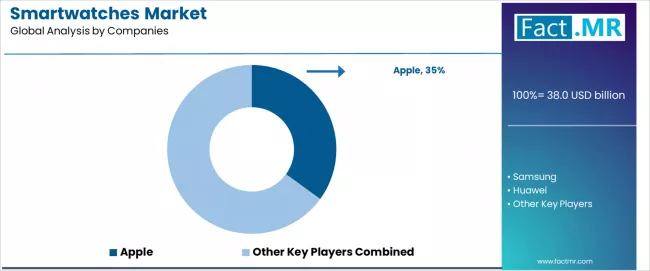
- Structure: ~15-20 credible players; top 3-5 hold ~70-75% by revenue.
- Leadership is maintained through: ecosystem integration, health innovation, and brand strength.
- What's commoditizing: basic fitness tracking and standard notification features.
- Margin Opportunities: medical-grade health monitoring, premium materials, and subscription services.
| Stakeholder | What they actually control | Typical strengths | Typical blind spots |
|---|---|---|---|
| Ecosystem leaders | Platform integration, app stores, health services | Seamless connectivity, brand loyalty, comprehensive features | Price sensitivity; niche markets |
| Health/fitness specialists | Medical accuracy, specialized tracking, coaching services | Fitness expertise, health validation | Ecosystem integration; mainstream appeal |
| Fashion/luxury brands | Design aesthetics, premium materials, brand prestige | Style differentiation, luxury positioning | Technical capabilities; price competition |
| Value/emerging players | Cost efficiency, regional focus, specific demographics | Affordability, local market knowledge | Technology gaps; ecosystem limitations |
Key Players in the Smartwatches Market
- Apple
- Samsung
- Huawei
- Garmin
- Fitbit/Google
- Amazfit
- Xiaomi
- Coros
- Polar
- Fossil Group
Scope of the Report
| Item | Value |
|---|---|
| Quantitative Units | USD 38 billion |
| Operating System | WatchOS, Wear OS, Proprietary/Others |
| Feature | Health/Fitness, Communication, Payments/GPS/Others |
| Price Tier | $200-399, ≥$400, <$200 |
| End Use | Fitness Tracking, Health Monitoring, Communication Management, Lifestyle Enhancement |
| Regions Covered | North America, Western Europe, East Asia, South Asia Pacific, Latin America, Middle East & Africa |
| Countries Covered | United States, Germany, United Kingdom, France, Japan, South Korea, Mexico, Canada, Italy, and 25+ additional countries |
| Key Companies Profiled | Apple, Samsung, Huawei, Garmin, Fitbit/Google, Amazfit, Xiaomi, Coros, Polar, Fossil Group |
| Additional Attributes | Dollar sales by operating system and feature categories, regional adoption trends across North America, Western Europe, and East Asia, competitive landscape with consumer electronics manufacturers and wearable technology providers, consumer preferences for health optimization and lifestyle integration, ecosystem connectivity with smartphone platforms and health management systems, innovations in wearable technology and health monitoring enhancement, and development of integrated wellness solutions with enhanced performance and lifestyle optimization capabilities. |
Smartwatches Market by Segments
-
Operating System :
- WatchOS
- Wear OS
- Proprietary/Others
-
Feature :
- Health/Fitness
- Communication
- Payments/GPS/Others
-
Price Tier :
- $200-399
- ≥$400
- <$200
-
End Use :
- Fitness Tracking
- Health Monitoring
- Communication Management
- Lifestyle Enhancement
-
Region :
- North America
- United States
- Canada
- Mexico
- Western Europe
- Germany
- United Kingdom
- France
- Italy
- Spain
- Nordic
- BENELUX
- Rest of Western Europe
- East Asia
- China
- Japan
- South Korea
- South Asia Pacific
- India
- ASEAN
- Australia & New Zealand
- Rest of South Asia Pacific
- Latin America
- Brazil
- Chile
- Rest of Latin America
- Middle East & Africa
- Kingdom of Saudi Arabia
- Other GCC Countries
- Turkey
- South Africa
- Other African Union
- Rest of Middle East & Africa
- North America
Table of Content
- Executive Summary
- Global Market Outlook
- Demand to side Trends
- Supply to side Trends
- Technology Roadmap Analysis
- Analysis and Recommendations
- Market Overview
- Market Coverage / Taxonomy
- Market Definition / Scope / Limitations
- Market Background
- Market Dynamics
- Drivers
- Restraints
- Opportunity
- Trends
- Scenario Forecast
- Demand in Optimistic Scenario
- Demand in Likely Scenario
- Demand in Conservative Scenario
- Opportunity Map Analysis
- Product Life Cycle Analysis
- Supply Chain Analysis
- Investment Feasibility Matrix
- Value Chain Analysis
- PESTLE and Porter’s Analysis
- Regulatory Landscape
- Regional Parent Market Outlook
- Production and Consumption Statistics
- Import and Export Statistics
- Market Dynamics
- Global Market Analysis 2020 to 2024 and Forecast, 2025 to 2035
- Historical Market Size Value (USD Million) Analysis, 2020 to 2024
- Current and Future Market Size Value (USD Million) Projections, 2025 to 2035
- Y to o to Y Growth Trend Analysis
- Absolute $ Opportunity Analysis
- Global Market Pricing Analysis 2020 to 2024 and Forecast 2025 to 2035
- Global Market Analysis 2020 to 2024 and Forecast 2025 to 2035, By Operating System
- Introduction / Key Findings
- Historical Market Size Value (USD Million) Analysis By Operating System , 2020 to 2024
- Current and Future Market Size Value (USD Million) Analysis and Forecast By Operating System , 2025 to 2035
- WatchOS
- Wear OS
- Proprietary/Others
- Y to o to Y Growth Trend Analysis By Operating System , 2020 to 2024
- Absolute $ Opportunity Analysis By Operating System , 2025 to 2035
- Global Market Analysis 2020 to 2024 and Forecast 2025 to 2035, By Feature
- Introduction / Key Findings
- Historical Market Size Value (USD Million) Analysis By Feature, 2020 to 2024
- Current and Future Market Size Value (USD Million) Analysis and Forecast By Feature, 2025 to 2035
- Health/Fitness
- Communication
- Payments/GPS/Others
- Y to o to Y Growth Trend Analysis By Feature, 2020 to 2024
- Absolute $ Opportunity Analysis By Feature, 2025 to 2035
- Global Market Analysis 2020 to 2024 and Forecast 2025 to 2035, By Region
- Introduction
- Historical Market Size Value (USD Million) Analysis By Region, 2020 to 2024
- Current Market Size Value (USD Million) Analysis and Forecast By Region, 2025 to 2035
- North America
- Latin America
- Western Europe
- Eastern Europe
- East Asia
- South Asia and Pacific
- Middle East & Africa
- Market Attractiveness Analysis By Region
- North America Market Analysis 2020 to 2024 and Forecast 2025 to 2035, By Country
- Historical Market Size Value (USD Million) Trend Analysis By Market Taxonomy, 2020 to 2024
- Market Size Value (USD Million) Forecast By Market Taxonomy, 2025 to 2035
- By Country
- USA
- Canada
- Mexico
- By Operating System
- By Feature
- By Country
- Market Attractiveness Analysis
- By Country
- By Operating System
- By Feature
- Key Takeaways
- Latin America Market Analysis 2020 to 2024 and Forecast 2025 to 2035, By Country
- Historical Market Size Value (USD Million) Trend Analysis By Market Taxonomy, 2020 to 2024
- Market Size Value (USD Million) Forecast By Market Taxonomy, 2025 to 2035
- By Country
- Brazil
- Chile
- Rest of Latin America
- By Operating System
- By Feature
- By Country
- Market Attractiveness Analysis
- By Country
- By Operating System
- By Feature
- Key Takeaways
- Western Europe Market Analysis 2020 to 2024 and Forecast 2025 to 2035, By Country
- Historical Market Size Value (USD Million) Trend Analysis By Market Taxonomy, 2020 to 2024
- Market Size Value (USD Million) Forecast By Market Taxonomy, 2025 to 2035
- By Country
- Germany
- UK
- Italy
- Spain
- France
- Nordic
- BENELUX
- Rest of Western Europe
- By Operating System
- By Feature
- By Country
- Market Attractiveness Analysis
- By Country
- By Operating System
- By Feature
- Key Takeaways
- Eastern Europe Market Analysis 2020 to 2024 and Forecast 2025 to 2035, By Country
- Historical Market Size Value (USD Million) Trend Analysis By Market Taxonomy, 2020 to 2024
- Market Size Value (USD Million) Forecast By Market Taxonomy, 2025 to 2035
- By Country
- Russia
- Poland
- Hungary
- Balkan & Baltic
- Rest of Eastern Europe
- By Operating System
- By Feature
- By Country
- Market Attractiveness Analysis
- By Country
- By Operating System
- By Feature
- Key Takeaways
- East Asia Market Analysis 2020 to 2024 and Forecast 2025 to 2035, By Country
- Historical Market Size Value (USD Million) Trend Analysis By Market Taxonomy, 2020 to 2024
- Market Size Value (USD Million) Forecast By Market Taxonomy, 2025 to 2035
- By Country
- China
- Japan
- South Korea
- By Operating System
- By Feature
- By Country
- Market Attractiveness Analysis
- By Country
- By Operating System
- By Feature
- Key Takeaways
- South Asia and Pacific Market Analysis 2020 to 2024 and Forecast 2025 to 2035, By Country
- Historical Market Size Value (USD Million) Trend Analysis By Market Taxonomy, 2020 to 2024
- Market Size Value (USD Million) Forecast By Market Taxonomy, 2025 to 2035
- By Country
- India
- ASEAN
- Australia & New Zealand
- Rest of South Asia and Pacific
- By Operating System
- By Feature
- By Country
- Market Attractiveness Analysis
- By Country
- By Operating System
- By Feature
- Key Takeaways
- Middle East & Africa Market Analysis 2020 to 2024 and Forecast 2025 to 2035, By Country
- Historical Market Size Value (USD Million) Trend Analysis By Market Taxonomy, 2020 to 2024
- Market Size Value (USD Million) Forecast By Market Taxonomy, 2025 to 2035
- By Country
- Kingdom of Saudi Arabia
- Other GCC Countries
- Turkiye
- South Africa
- Other African Union
- Rest of Middle East & Africa
- By Operating System
- By Feature
- By Country
- Market Attractiveness Analysis
- By Country
- By Operating System
- By Feature
- Key Takeaways
- Key Countries Market Analysis
- USA
- Pricing Analysis
- Market Share Analysis, 2024
- By Operating System
- By Feature
- Canada
- Pricing Analysis
- Market Share Analysis, 2024
- By Operating System
- By Feature
- Mexico
- Pricing Analysis
- Market Share Analysis, 2024
- By Operating System
- By Feature
- Brazil
- Pricing Analysis
- Market Share Analysis, 2024
- By Operating System
- By Feature
- Chile
- Pricing Analysis
- Market Share Analysis, 2024
- By Operating System
- By Feature
- Germany
- Pricing Analysis
- Market Share Analysis, 2024
- By Operating System
- By Feature
- UK
- Pricing Analysis
- Market Share Analysis, 2024
- By Operating System
- By Feature
- Italy
- Pricing Analysis
- Market Share Analysis, 2024
- By Operating System
- By Feature
- Spain
- Pricing Analysis
- Market Share Analysis, 2024
- By Operating System
- By Feature
- France
- Pricing Analysis
- Market Share Analysis, 2024
- By Operating System
- By Feature
- India
- Pricing Analysis
- Market Share Analysis, 2024
- By Operating System
- By Feature
- ASEAN
- Pricing Analysis
- Market Share Analysis, 2024
- By Operating System
- By Feature
- Australia & New Zealand
- Pricing Analysis
- Market Share Analysis, 2024
- By Operating System
- By Feature
- China
- Pricing Analysis
- Market Share Analysis, 2024
- By Operating System
- By Feature
- Japan
- Pricing Analysis
- Market Share Analysis, 2024
- By Operating System
- By Feature
- South Korea
- Pricing Analysis
- Market Share Analysis, 2024
- By Operating System
- By Feature
- Russia
- Pricing Analysis
- Market Share Analysis, 2024
- By Operating System
- By Feature
- Poland
- Pricing Analysis
- Market Share Analysis, 2024
- By Operating System
- By Feature
- Hungary
- Pricing Analysis
- Market Share Analysis, 2024
- By Operating System
- By Feature
- Kingdom of Saudi Arabia
- Pricing Analysis
- Market Share Analysis, 2024
- By Operating System
- By Feature
- Turkiye
- Pricing Analysis
- Market Share Analysis, 2024
- By Operating System
- By Feature
- South Africa
- Pricing Analysis
- Market Share Analysis, 2024
- By Operating System
- By Feature
- USA
- Market Structure Analysis
- Competition Dashboard
- Competition Benchmarking
- Market Share Analysis of Top Players
- By Regional
- By Operating System
- By Feature
- Competition Analysis
- Competition Deep Dive
- Apple
- Overview
- Product Portfolio
- Profitability by Market Segments (Product/Age /Sales Channel/Region)
- Sales Footprint
- Strategy Overview
- Marketing Strategy
- Product Strategy
- Channel Strategy
- Samsung
- Huawei
- Garmin
- Fitbit/Google
- Amazfit
- Xiaomi
- Coros
- Polar
- Fossil Group
- Apple
- Competition Deep Dive
- Assumptions & Acronyms Used
- Research Methodology
List Of Table
- Table 1: Global Market Value (USD Million) Forecast by Region, 2020 to 2035
- Table 2: Global Market Value (USD Million) Forecast by Operating System , 2020 to 2035
- Table 3: Global Market Value (USD Million) Forecast by Feature, 2020 to 2035
- Table 4: North America Market Value (USD Million) Forecast by Country, 2020 to 2035
- Table 5: North America Market Value (USD Million) Forecast by Operating System , 2020 to 2035
- Table 6: North America Market Value (USD Million) Forecast by Feature, 2020 to 2035
- Table 7: Latin America Market Value (USD Million) Forecast by Country, 2020 to 2035
- Table 8: Latin America Market Value (USD Million) Forecast by Operating System , 2020 to 2035
- Table 9: Latin America Market Value (USD Million) Forecast by Feature, 2020 to 2035
- Table 10: Western Europe Market Value (USD Million) Forecast by Country, 2020 to 2035
- Table 11: Western Europe Market Value (USD Million) Forecast by Operating System , 2020 to 2035
- Table 12: Western Europe Market Value (USD Million) Forecast by Feature, 2020 to 2035
- Table 13: Eastern Europe Market Value (USD Million) Forecast by Country, 2020 to 2035
- Table 14: Eastern Europe Market Value (USD Million) Forecast by Operating System , 2020 to 2035
- Table 15: Eastern Europe Market Value (USD Million) Forecast by Feature, 2020 to 2035
- Table 16: East Asia Market Value (USD Million) Forecast by Country, 2020 to 2035
- Table 17: East Asia Market Value (USD Million) Forecast by Operating System , 2020 to 2035
- Table 18: East Asia Market Value (USD Million) Forecast by Feature, 2020 to 2035
- Table 19: South Asia and Pacific Market Value (USD Million) Forecast by Country, 2020 to 2035
- Table 20: South Asia and Pacific Market Value (USD Million) Forecast by Operating System , 2020 to 2035
- Table 21: South Asia and Pacific Market Value (USD Million) Forecast by Feature, 2020 to 2035
- Table 22: Middle East & Africa Market Value (USD Million) Forecast by Country, 2020 to 2035
- Table 23: Middle East & Africa Market Value (USD Million) Forecast by Operating System , 2020 to 2035
- Table 24: Middle East & Africa Market Value (USD Million) Forecast by Feature, 2020 to 2035
List Of Figures
- Figure 1: Global Market Pricing Analysis
- Figure 2: Global Market Value (USD Million) Forecast 2020-2035
- Figure 3: Global Market Value Share and BPS Analysis by Operating System , 2025 and 2035
- Figure 4: Global Market Y to o to Y Growth Comparison by Operating System , 2025-2035
- Figure 5: Global Market Attractiveness Analysis by Operating System
- Figure 6: Global Market Value Share and BPS Analysis by Feature, 2025 and 2035
- Figure 7: Global Market Y to o to Y Growth Comparison by Feature, 2025-2035
- Figure 8: Global Market Attractiveness Analysis by Feature
- Figure 9: Global Market Value (USD Million) Share and BPS Analysis by Region, 2025 and 2035
- Figure 10: Global Market Y to o to Y Growth Comparison by Region, 2025-2035
- Figure 11: Global Market Attractiveness Analysis by Region
- Figure 12: North America Market Incremental Dollar Opportunity, 2025-2035
- Figure 13: Latin America Market Incremental Dollar Opportunity, 2025-2035
- Figure 14: Western Europe Market Incremental Dollar Opportunity, 2025-2035
- Figure 15: Eastern Europe Market Incremental Dollar Opportunity, 2025-2035
- Figure 16: East Asia Market Incremental Dollar Opportunity, 2025-2035
- Figure 17: South Asia and Pacific Market Incremental Dollar Opportunity, 2025-2035
- Figure 18: Middle East & Africa Market Incremental Dollar Opportunity, 2025-2035
- Figure 19: North America Market Value Share and BPS Analysis by Country, 2025 and 2035
- Figure 20: North America Market Value Share and BPS Analysis by Operating System , 2025 and 2035
- Figure 21: North America Market Y to o to Y Growth Comparison by Operating System , 2025-2035
- Figure 22: North America Market Attractiveness Analysis by Operating System
- Figure 23: North America Market Value Share and BPS Analysis by Feature, 2025 and 2035
- Figure 24: North America Market Y to o to Y Growth Comparison by Feature, 2025-2035
- Figure 25: North America Market Attractiveness Analysis by Feature
- Figure 26: Latin America Market Value Share and BPS Analysis by Country, 2025 and 2035
- Figure 27: Latin America Market Value Share and BPS Analysis by Operating System , 2025 and 2035
- Figure 28: Latin America Market Y to o to Y Growth Comparison by Operating System , 2025-2035
- Figure 29: Latin America Market Attractiveness Analysis by Operating System
- Figure 30: Latin America Market Value Share and BPS Analysis by Feature, 2025 and 2035
- Figure 31: Latin America Market Y to o to Y Growth Comparison by Feature, 2025-2035
- Figure 32: Latin America Market Attractiveness Analysis by Feature
- Figure 33: Western Europe Market Value Share and BPS Analysis by Country, 2025 and 2035
- Figure 34: Western Europe Market Value Share and BPS Analysis by Operating System , 2025 and 2035
- Figure 35: Western Europe Market Y to o to Y Growth Comparison by Operating System , 2025-2035
- Figure 36: Western Europe Market Attractiveness Analysis by Operating System
- Figure 37: Western Europe Market Value Share and BPS Analysis by Feature, 2025 and 2035
- Figure 38: Western Europe Market Y to o to Y Growth Comparison by Feature, 2025-2035
- Figure 39: Western Europe Market Attractiveness Analysis by Feature
- Figure 40: Eastern Europe Market Value Share and BPS Analysis by Country, 2025 and 2035
- Figure 41: Eastern Europe Market Value Share and BPS Analysis by Operating System , 2025 and 2035
- Figure 42: Eastern Europe Market Y to o to Y Growth Comparison by Operating System , 2025-2035
- Figure 43: Eastern Europe Market Attractiveness Analysis by Operating System
- Figure 44: Eastern Europe Market Value Share and BPS Analysis by Feature, 2025 and 2035
- Figure 45: Eastern Europe Market Y to o to Y Growth Comparison by Feature, 2025-2035
- Figure 46: Eastern Europe Market Attractiveness Analysis by Feature
- Figure 47: East Asia Market Value Share and BPS Analysis by Country, 2025 and 2035
- Figure 48: East Asia Market Value Share and BPS Analysis by Operating System , 2025 and 2035
- Figure 49: East Asia Market Y to o to Y Growth Comparison by Operating System , 2025-2035
- Figure 50: East Asia Market Attractiveness Analysis by Operating System
- Figure 51: East Asia Market Value Share and BPS Analysis by Feature, 2025 and 2035
- Figure 52: East Asia Market Y to o to Y Growth Comparison by Feature, 2025-2035
- Figure 53: East Asia Market Attractiveness Analysis by Feature
- Figure 54: South Asia and Pacific Market Value Share and BPS Analysis by Country, 2025 and 2035
- Figure 55: South Asia and Pacific Market Value Share and BPS Analysis by Operating System , 2025 and 2035
- Figure 56: South Asia and Pacific Market Y to o to Y Growth Comparison by Operating System , 2025-2035
- Figure 57: South Asia and Pacific Market Attractiveness Analysis by Operating System
- Figure 58: South Asia and Pacific Market Value Share and BPS Analysis by Feature, 2025 and 2035
- Figure 59: South Asia and Pacific Market Y to o to Y Growth Comparison by Feature, 2025-2035
- Figure 60: South Asia and Pacific Market Attractiveness Analysis by Feature
- Figure 61: Middle East & Africa Market Value Share and BPS Analysis by Country, 2025 and 2035
- Figure 62: Middle East & Africa Market Value Share and BPS Analysis by Operating System , 2025 and 2035
- Figure 63: Middle East & Africa Market Y to o to Y Growth Comparison by Operating System , 2025-2035
- Figure 64: Middle East & Africa Market Attractiveness Analysis by Operating System
- Figure 65: Middle East & Africa Market Value Share and BPS Analysis by Feature, 2025 and 2035
- Figure 66: Middle East & Africa Market Y to o to Y Growth Comparison by Feature, 2025-2035
- Figure 67: Middle East & Africa Market Attractiveness Analysis by Feature
- Figure 68: Global Market - Tier Structure Analysis
- Figure 69: Global Market - Company Share Analysis
- FAQs -
How big is the smartwatches market in 2025?
The global smartwatches market is estimated to be valued at USD 38.0 billion in 2025.
What will be the size of smartwatches market in 2035?
The market size for the smartwatches market is projected to reach USD 60.2 billion by 2035.
How much will be the smartwatches market growth between 2025 and 2035?
The smartwatches market is expected to grow at a 4.7% CAGR between 2025 and 2035.
What are the key product types in the smartwatches market?
The key product types in smartwatches market are watchos, wear os and proprietary/others.
Which feature segment to contribute significant share in the smartwatches market in 2025?
In terms of feature, health/fitness segment to command 49.0% share in the smartwatches market in 2025.